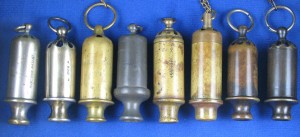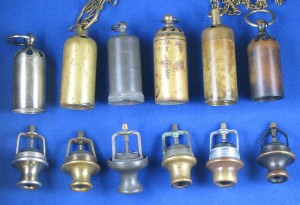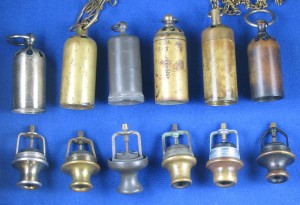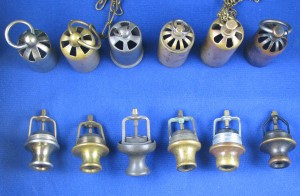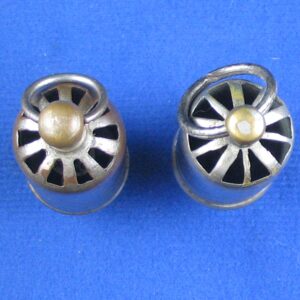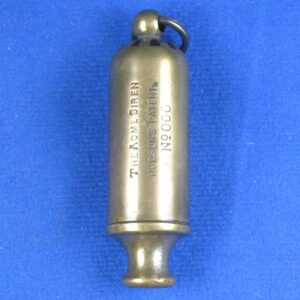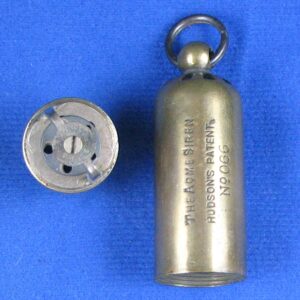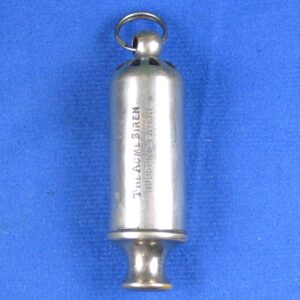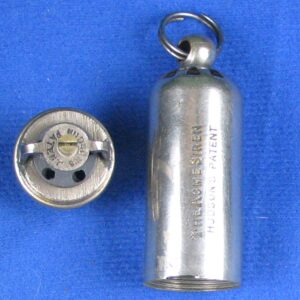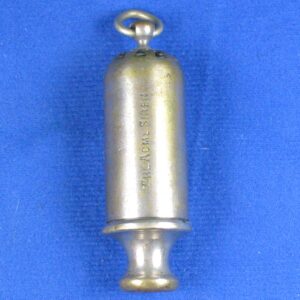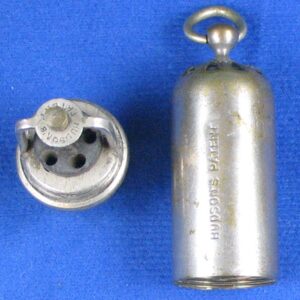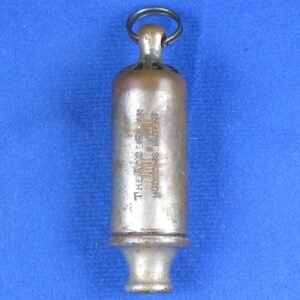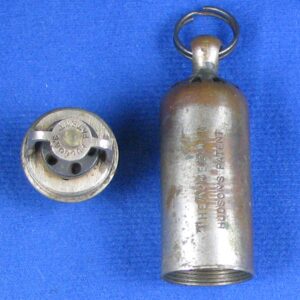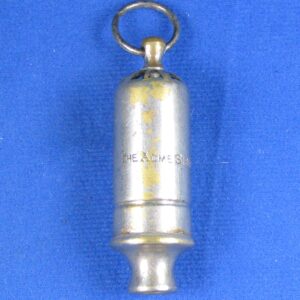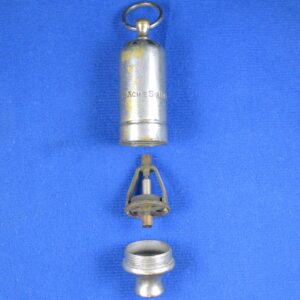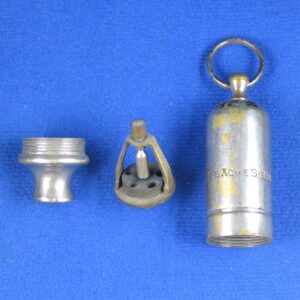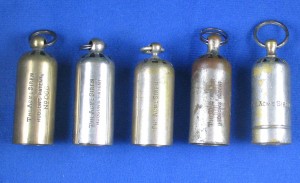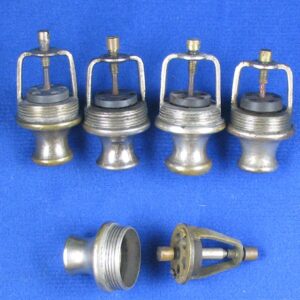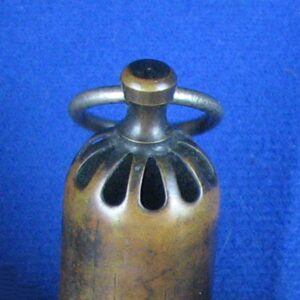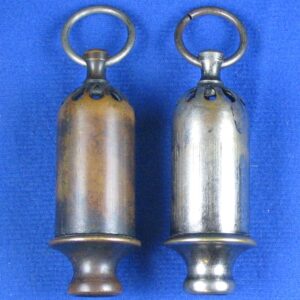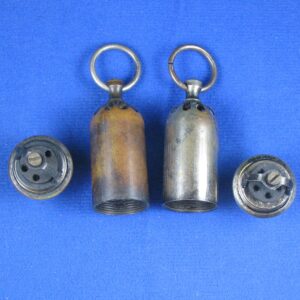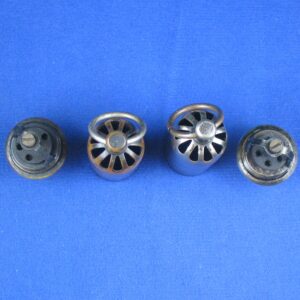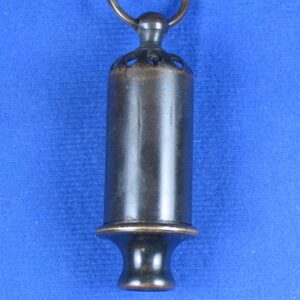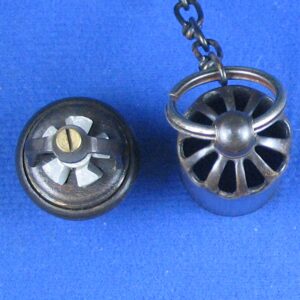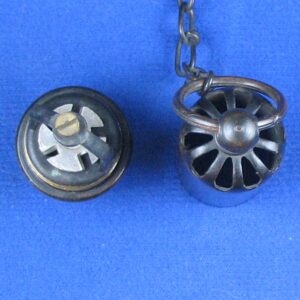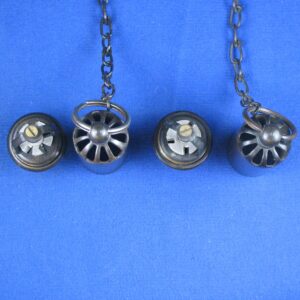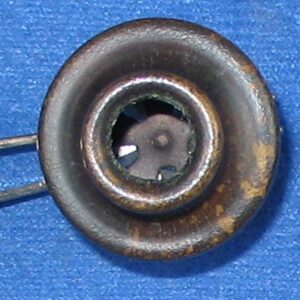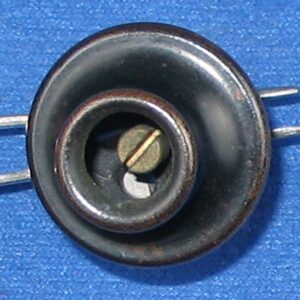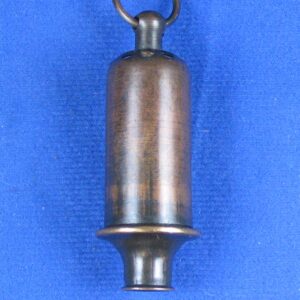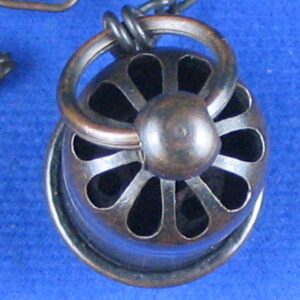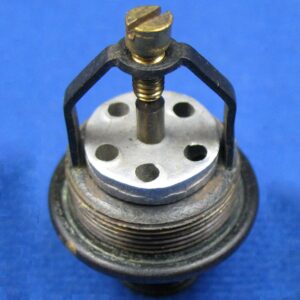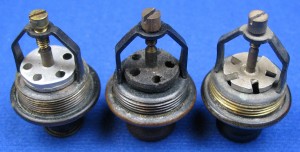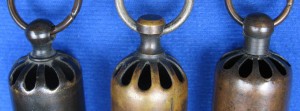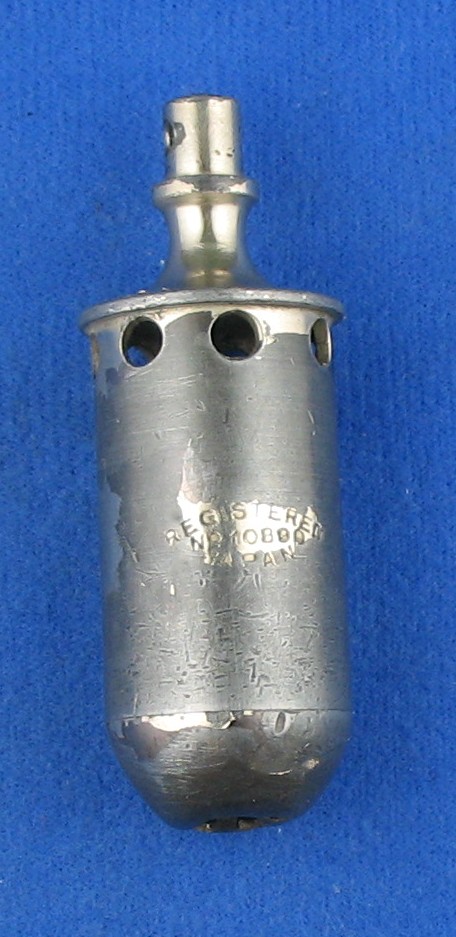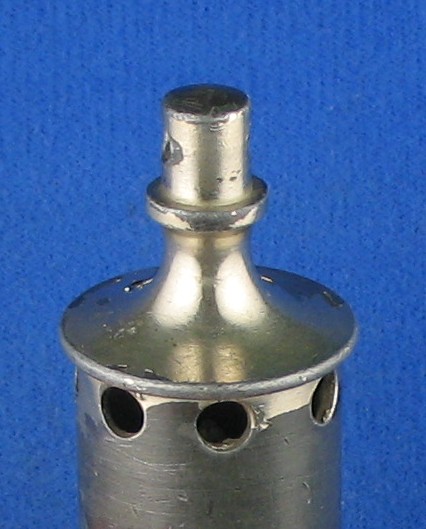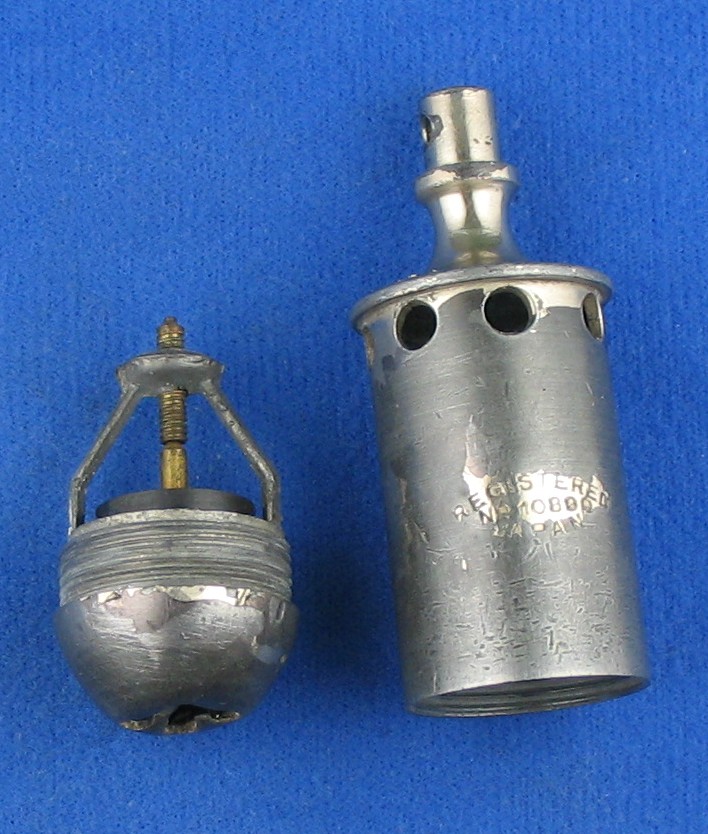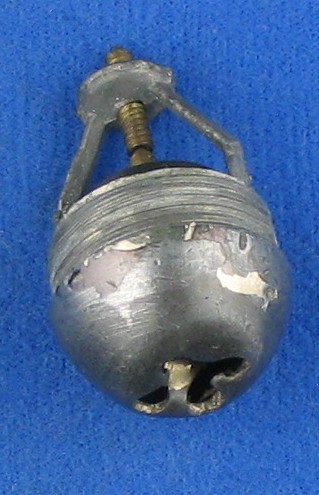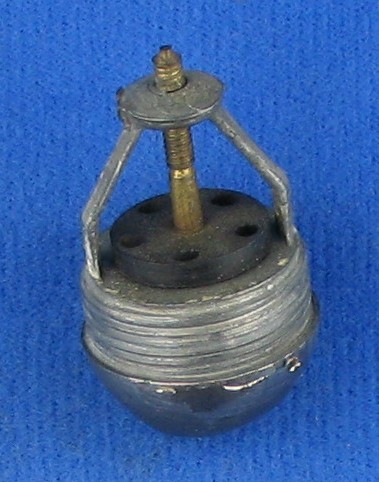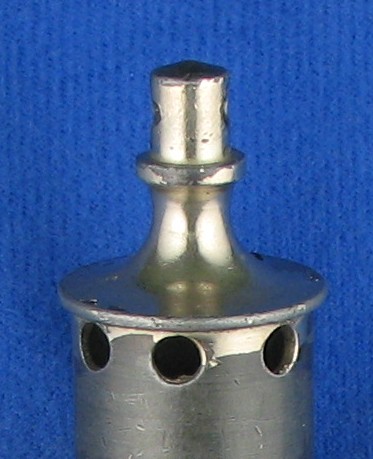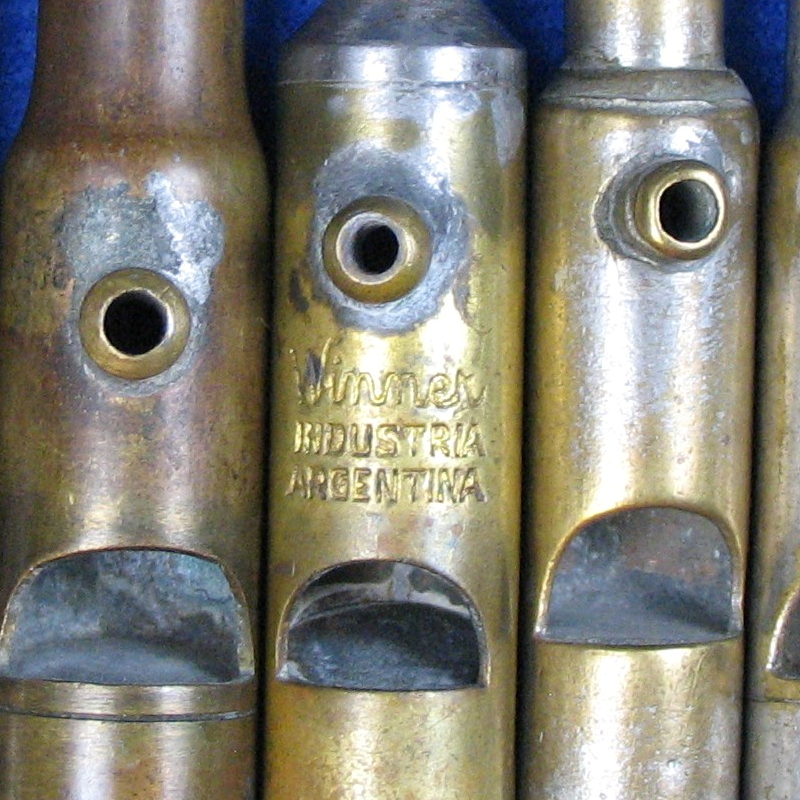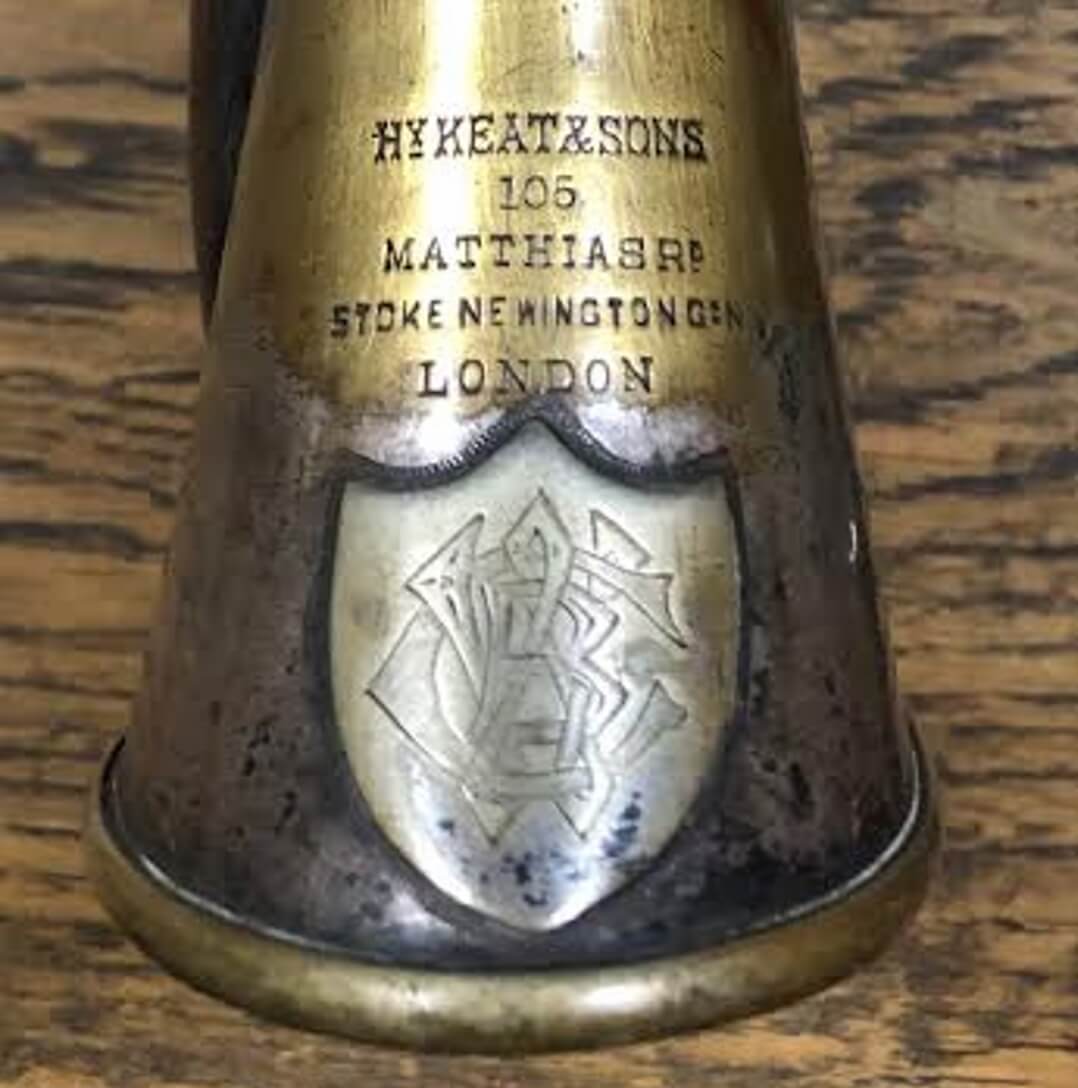Spotlight > Whistle Categories > Siren > 042
Sirens, compared to whistles, date back far less in time. Indeed the first siren can be traced back 215 years to 1799, whereas whistles may date back as far as man and musical instruments. In this SPOTLIGHT when referring to sirens references will be made to mouth driven sirens in particular. In researching the subject of sirens we found that they are most commonly recognized by the case designed and registered by Joseph Hudson from the UK, so that we had to divide the article into four parts. Part one will be focusing on these ‘case’ sirens, part two focusing on German and French ‘torpedo’ sirens, part three ‘thin walled’ sirens and part four all others. There are literally hundreds of designs. Materials include, plastic, tin, silver, brittania, steel, brass, copper, ivory, paper, bakelite and ??
It turns out that in no way can we include the entire scope of sirens in these articles. It would take far too many years to accumulate the variety involved and the outlay would be prohibitive to do so. Because we make every effort to only present from the reference collection, whistles and sirens we own, photograph and write about, it limits what we can show. Instead, four basic articles are presented to build further on what Martyn Gilchrist started in More Whistles pages 74 and 75, 2005. From there the four articles can be used as a framework. Hopefully others will present what they find also adding to the world wide fund of knowledge. We will endeavor to add significant sirens to the reference collection and to the articles as things develop. Adding to this, pictures that are contributed from the readers may be added in, as appropriate.
Very little has been written about mouth driven sirens. We easily find information on pneumatic and electric driven sirens used for emergency vehicles, industrial signaling, nautical applications, public warnings and so on. However for our purposes we want to concentrate on mouth driven ( hand blown ) sirens. Closely akin to whistles, these date back prior to 1900. We have seen silver ( maiden’s alarms ) presented on auction dating back at least to 1881 ( with hallmarks ). It is not known how far back sirens date past this date.
In the year 1895 three significant sirens emerged all at once and went to print —- creating a pivotal point in history.
1) The first known patent in Germany was a patent filed for as a ‘torpedo’ siren. (Pietschmann)
January 16th 1895
2) In 1895 a registered design ( different from a patent ) for a case only was registered in England (Hudson).
3) These coincided with a thin walled siren in America (Wardwell & Mossberg) which was a patent.
January 17th 1895 ( applied for, granted April 16th )
All three had very different and especially important design characteristics, notably the Wardwell/Mossberg as it expanded the marketability of less expensive sirens.
In 1799 John Robison ( Scotland ) wrote an article for the third edition of Encyclopedia Britannica for his invention of the syren. He used a stopcock valve that shut and opened the passage of a pipe 720 times in a second, and was fitted to the wind chest of an organ. So the first siren was used for music.
Within 20 years, Charles Cagniard De La Tour ( France ) improved it and instead of a stopcock and a pipe used a disk with evenly spaced holes around its edge. The disk rotates at high speed, and interrupts at regular intervals a jet ( puff ) of air, directed at the holes. The rate of spin, holes, angles, contribute to the variable pitches. Due to the ability to be heard under water this lent to Cagniard naming it the syren from Greek mythology.
Technically, the spinning disc is called the rotor ( or chopper ) and the stationary disc the stator. Beyond this is a body for housing the mechanism and perhaps a top fitting. For this article there will always be a mouthpiece. Additionally there may be a bracket holding the rotor ( or wheel ) attached or not to the mouthpiece, The stator may or may not be incorporated into the mouthpiece but usually is.
Sirens are not whistles or are they ?? Well, it is certain you blow through them. However the sound split by the angle of a single fipple in a whistle is lacking. Instead, a whirring noise is created in a siren that is variable with the air you blow through. On the other hand each opening has its own angled opening like tiny fipples and understandably under the right conditions the pitch can reach very high levels as it accelerates.
That being said, sirens are typically, but of course not always, made by whistle manufacturers. They are so closely akin that many people place them in the same category. In fact, Martyn Gilchrist wrote and pictured in More Whistles the first material on mouth driven sirens, doing so with two full pages. While he focused on Hudson sirens, there are many more sirens to be recorded, both with similar cases and without.
The thrust of these articles attempts to expand the subject. Gilchrist’s emphasis was on the Hudson siren which can be seen to have stayed within a certain concept of what was first described and registered in 1895 – the ‘case’. Very little has been changed in their production even to this day. Starting with its patented mechanism of 1907 ( patent 24900 in the UK – Hudson ) they modified the mechanism in 1921 ( Gilchrist ) and then returned to their earlier patented design. Curiously Hudson registered the ‘case’ 13 years before they patented the mechanism. It makes one wonder why the large gap?
Two similar models were presented in 1907 ( with an open top case ) and another larger case in 1910 ( 126 mm ) All others were very close in design, structure and lengths in which these had either 10 vents (early on 1908-1920s) and later 6 vents (1920s – to present). Hudson also used horn attachments ( described with the 1907 patent ), but it is the same overall design of the mouthpiece and case, albeit with different attachments. There are many very small variations for the collector to search for and study and some will be presented here for comparison.
In our study of Sirens, the first article will follow that pattern of design of the ‘case type siren’ to compliment Martyn Gilchrist’s work on Hudson sirens and expanding them further into other manufacturers. The second article will focus on torpedo sirens from Germany and France. The third article will focus on thin wall sirens of 1895 from America and forward. The fourth will be for a variety outside the first three articles.
CASED SIRENS
We will note the following identifying features to learn about and use in identifying case sirens.
1) vents ( amount, shape, location )
2) case designs ( model 147 in Hudson’s )
3) mechanisms ( incorporated or not into the mouthpiece and components )
4) knops ( round, pillar, cone, rings, hour glass )
5) wheel material and design ( hard rubber, synthetic, aluminum, plastic )
Typical of these sirens ( syrens in the original descriptions ) is the design registered by Hudson in 1895. The following picture reveals what many used from this design. Included here is the 1895 registered design that Joseph Hudson filed.
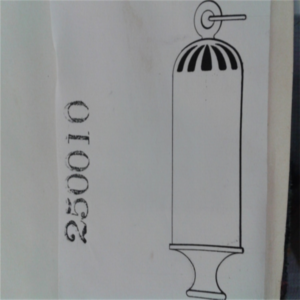
( photograph courtesy of Stephen Dulken )
1907 patent Hudson siren nautical diagram reprinted in its entirety. This includes the mechanism. However the mechanism had already been in use for many years.
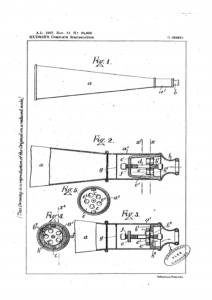
( photograph courtesy of Stephen Dulken )
There were silver smiths that made the same style body and used the Hudson mechanism. Other manufacturers used the same body design and their own ( but similar ) mechanism. Pictured here are similar types from Germany, France?, America and England. Two others have been seen from China and Argentina ( not pictured ) and undoubtably more are yet to be seen.
Pictured first is a variety of fully cased sirens to date matching the 1895 case design by Hudson. A further breakdown will follow of:
1) UK sirens
2) French sirens ?
3) American sirens
4) German sirens
The following eight sirens are as follows:
1) Hudson, Joseph ( pre 1920 )
2) Hallmarked silver W.K. ??
3) Hudson ( post 1920 )
4) Pewter ( unknown manufacturer )
5) Signal, Martin
6) Omnibus Collection International ??
7) unknown American
8) unknown American
In the following picture we see the cases pulled apart from the mechanism. Pulled apart one can see that the mechanisms are all basically the same with minor variations.
Each has a bracket that is incorporated into the mouthpiece along with the stator. In each of these we note that the ‘wheel’ is made of a hard rubber or in the case of the American maker it is a hard – almost compressed paper material. Each has an adjustment to the top and inside the mouthpiece is a second one. One example from America has eliminated the adjustment inside the mouthpiece.
So top and bottom can be adjusted. When the wheel is just loose enough to spin freely the siren sound tends to carry on with centrifugal force. If too loose it has a wobbly sound. No lubrication is used, but kept dry and clean it spins freely.
Variations in the top cap or knops are as follows, but not limited to :
1) large round
2) small round
3) conical
4) pillar
5) hourglass
6) steel ( shown later )
Only the pewter model has threads on the exterior of the case. All the others have internal threads.
Note the vents in particular, vents seen here number 5, 6, 8, and 10. Perhaps there will be others yet. The Pillar top possibly was made in Germany. The two sirens have two piece cases with the Signal being more detailed.
Vents are as follows but not limited to :
1) 2 vents – Jenning’s ( second article )
2) 3 vents – Mossberg, Chase ( second article )
3) 5 vents – pewter
4) 6 vents – Hudson, German
5) 7 vents – German, French ( second article )
6) 8 vents – silver
7) 10 vents – Signal, American
Vents are a very useful tool in separating and identifying case sirens. Their shape and pattern is revealing. Their number helps in dating them too.
As we shall see this will prove true in identifying and classifying Torpedo sirens also and even with thin wall sirens to some extent.
Vents are varied in shape ( i.e. round, angled, triangular, pear, kidney )
Even from year to year vents can vary as is seen from two Hudson’s as pictured:
It should be noted along the way that all the choppers ( or wheels ) have 5 holes in cased sirens. Each is cut at an angle to help with forward thrust. It helps to accelerate the speed of the wheel. The Hudson’s holes are the most angled and slightly larger than its counterparts. In other siren designs, the holes vary in number.
Now to concentrate on Hudson sirens and their progression from concept in 1895 we will view them pictured from 1908 to 1920. Unfortunately the open top siren pictured on page 74 More Whistles hasn’t been obtained yet. An example sold for over 500 dollars on auction and is very rare.
Model number 147 with number 066 stamped on the side is the earliest after the open top 1907. The larger knop is present and seen on others circa 1908. Note the mechanism at inception with the hard rubber wheel. Also the stamp for Hudson’s patent is on the bracket at first.
Close examination displays the different knops used in succession over the years by Hudson’s company.
Following this comes the only innovation of this model. In 1921 ( Gilchrist, More Whistles ) a location pressing was used and the mechanism was now separate from the mouthpiece. So the siren was now in three parts. Production soon returned to the two piece patent. Pictured here is a rare example with a round knop instead of a cone shaped top piece.
These are two early version 3-piece sirens by Hudson. One is a 6-vent and the other 10-vent. These were followed with a cone-top 6-vent and then it returned to 2-piece construction.
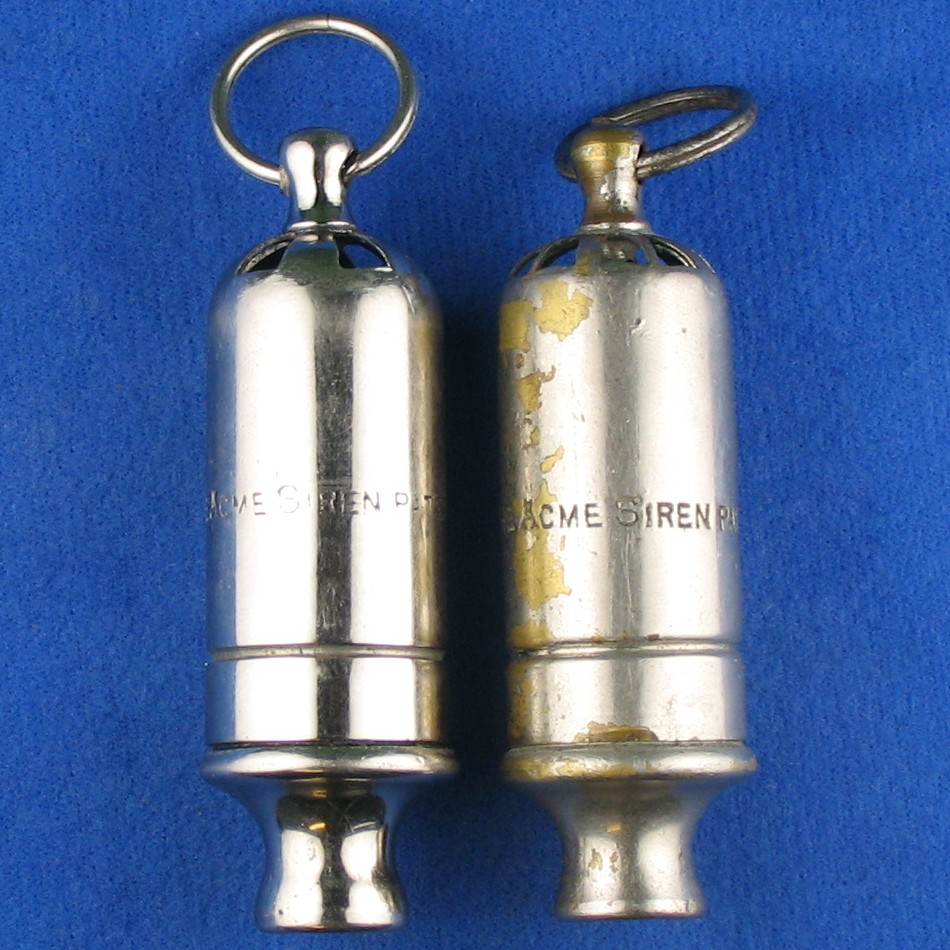
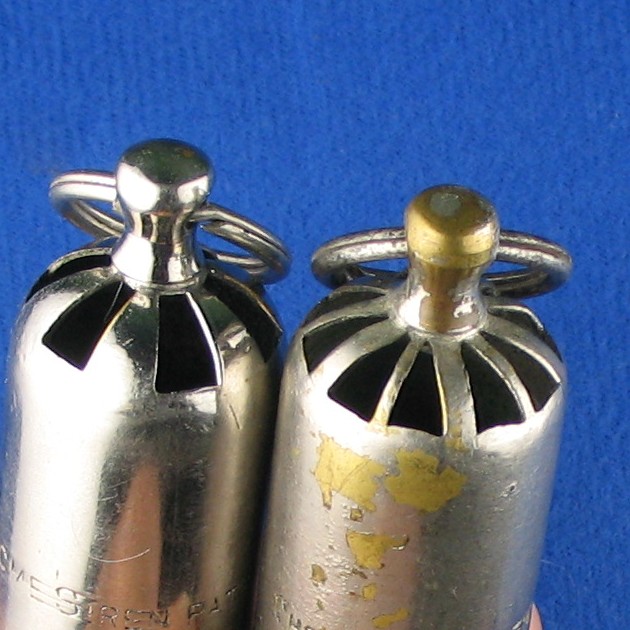
(Added June 23, 2018)
Side by side one can see the progression and variations over the years. Apparently Hudson’s would also use older parts from time to time, so that dating accurately of an exact progression is difficult.
Next we move on to American made sirens. German made sirens of this type are the largest at approximately 77mm or more, Hudson’s within 75mm – 76mm and the smallest are American at under 75mm.
The two examples are with the unique hourglass tops that can be seen on escargots made by the same maker. Only two models have been found with this unique hourglass knop from the USA, the siren and the escargot from this manufacturer.
Notice the vents are a ‘flower’ top design. These are the only American ones to date with hard pressed, oiled ? paper wheels inside. American sirens mainly utilized aluminum wheels of several designs.
The following show the different types of wheels identifying three separate manufacturers. Two different wheels were made by the same maker. Pictured as follows:
The siren just seen on the left interestingly has no adjustment inside the mouthpiece. The one on the right does.
Lastly the only copper siren known to date is pictured next. It has an unusual and distinctive steel knop and matches two other whistles by the same American manufacturer ( one is a GSW and one is an escargot whistle ).
The escargot has the same steel knop as the siren and the GSW has the same distinct mouthpiece as the siren and is also copper. This is unusual to use copper. Note the very different aluminum wheel inside the siren, yet it is still aluminum.
It also has the same ‘flower’ type vents.
Some comparisons in the American models as follows
What conclusions can we draw at this juncture ??
!) At least 6 countries utilized the Hudson 1895 design (i.e. UK, Germany, USA, France, China, Argentina)
2) Wide variety of top fittings can be used as identifying features.
3) Vents can be used as identifying features.
4) Nickle plated brass, silver, brass, copper, and brittania were used
5) Two, three and four piece construction also features in identification.
6) ****Three countries produced sirens independently and simultaneously in 1895
A larger model pictured on page 74 of More Whistles ( Well worth looking at ) is missing for now, as well as a larger German model also not pictured yet. Other models made were variations of Hudson’s prototype of 1895 design.
It has taken much more time and effort to get to this point than anticipated and that is good, as it shows us what there is to still learn and discover about sirens ( AKA syrens ). We hope that you have enjoyed this subject as well as we have and will be able to use this material presented for what Martyn Gilchrist described as ‘the body of knowledge’. Please feel free to write for any errata you may spot or have discovered ) and we will take note and make corrections for us all to use.
– TWG
Posted March 5, 2015
Addendum: Posted September 4, 2016
